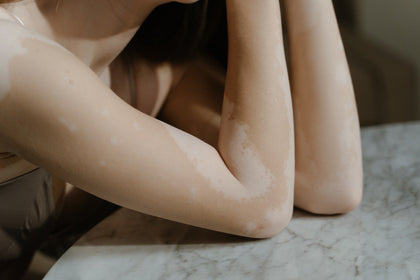Vitiligo, a condition that impacts skin pigmentation, is commonly thought to belong to a larger family of over 80 different conditions called autoimmune disorders. It’s estimated that about 70 million people worldwide have vitiligo, and more broadly, it is believed that autoimmune conditions impact about 4% of the world’s population.
Is there a connection between vitiligo and alopecia? Read on to understand how vitiligo could be related to other autoimmune disorders, what role these conditions might play in hair loss — plus, what you can do to combat thinning hair ASAP.
#include-related-slider#
What Is Vitiligo?
Vitiligo (vit-ih-LIE-go) is a skin condition that causes patches of skin to lose color (or pigmentation), which in turn makes them appear white or pink. Because pigmentation is present in both hair and skin, people with vitiligo might notice the graying of their hair in addition to losing pigment in their skin.
Despite what many people assume, it’s not a contagious condition. And while the exact causes of vitiligo aren’t well understood, it is believed to be caused by an immune system disorder. With these conditions, the immune system mistakenly attacks its own healthy tissues instead of foreign cells such as viruses or bacteria. With vitiligo, the immune system dysfunction impacts epidermal melanocytes, the cells that make pigment for our skin.
Aside from the depigmentation of skin, there aren’t that many symptoms associated with vitiligo. The affected skin doesn’t usually become irritated, though a small number of people might experience itching or inflammation on the affected patches of skin.
There are three common types, or patterns, in vitiligo patients:
- Focal Vitiligo: Patches of depigmentation appear in one generalized area.
- Generalized Vitiligo: Also called non-segmental or complete vitiligo, this is the most common pattern. Patches appear in a symmetrical pattern on both sides of the body.
- Segmental Vitiligo: A less common form of vitiligo where patches appear on one side of the body only.
Not everyone with a family history of vitiligo will develop this condition, but it’s estimated that 30% of people with vitiligo have a family history.
There is no cure for vitiligo, but common treatments include topical corticosteroids, topical calcineurin inhibitors and narrowband ultraviolet phototherapy. In more severe or quickly progressing cases, systemic treatments like corticosteroids, immunosuppressants or other immune-modifying agents might also be used.
Explore: The GRO Collection for Thinning Hair
How Is Vitiligo Connected to Hair Loss?
Vitiligo itself is not known to cause hair loss. However, because vitiligo is an autoimmune condition, it might be connected to other autoimmune conditions that can cause hair loss.
According to the Vitiligo Society, 15-25% of people with vitiligo may also be affected by one (or more) other autoimmune diseases such as thyroid dysfunction, rheumatoid arthritis, type 1 diabetes, psoriasis or Addison disease.
One autoimmune condition, in particular, called alopecia areata, seems to share many similarities with vitiligo.
Shop: Compare GRO vs GRO+ Advanced
Vitiligo and Alopecia Areata
Both vitiligo and alopecia areata are common autoimmune conditions, which are considered to be disfiguring skin diseases. While vitiligo causes discoloration of the skin, alopecia areata (AA) causes patchy hair loss.
Alopecia areata patients typically see their round coin-sized patches of hair loss spontaneously recover and grow back, though it can become a chronic recurring condition. The most severe forms of AA can cause baldness on the entire scalp (called alopecia totalis) or loss of all body hair (called alopecia universalis).
Despite their different outward appearances, there is evidence to support that the underlying causes of these two conditions share several similarities.
One commonality seems to be the disease activity in both the innate and adaptive immune systems. The innate (or nonspecific) immune system is the defense system that you were born with, and it offers the first line of defense whenever the body is faced with a foreign intruder like a virus or bacteria. The adaptive immune system kicks in if the innate system cannot fight off an invader. It is a more specific line of defense, and it can learn to identify new diseases or infections.
High cellular stress levels in the innate immune system might be initial triggers of disease in both AA and vitiligo, along with increased reactive oxygen species. Reactive oxygen species (RSO) play an important role in the killing response of immune cells to microbial invasion. In addition to these similarities, genome-wide association studies suggest that there might be common genetic risk factors for both alopecia areata and vitiligo pathogenesis.
Vitiligo and AA share other similarities, too. They both present in patches on the body and develop earlier in life. While AA can develop at any age, 60% of patients develop their first episode of hair loss before the age of 20. Similarly, half of vitiligo patients develop the disease before the age of 20 years old.
While it appears to be very rare, some people might have an emerging clinical variant called alopecia areata and vitiligo “overlap syndrome,” or coexisting cases of vitiligo and alopecia areata. It is estimated that 3% to 8% of vitiligo patients might also have alopecia areata.
Ultimately, researchers hope that understanding the close connections between vitiligo and AA can guide the development of future targeted treatments.
Other Autoimmune Conditions, Vitiligo and Hair Loss
Generally speaking, people who have one autoimmune condition might be more likely to develop another, or they may have coexisting autoimmune conditions.
While more direct research is needed, there seems to be an increased likelihood that folks with alopecia areata might develop a thyroid disease, with high-end estimates claiming that as many as 28% of AA patients have an associated thyroid disorder. The same appears to be consistent in vitiligo patients. One study in Thai patients showed 19.4% also had a thyroid disorder.
People with vitiligo might also face a unique risk of developing “multiple autoimmune syndrome” (MAS). In MAS, patients will have three or more coexisting autoimmune conditions. In addition, vitiligo patients seem to be at a higher risk for pernicious anemia, an autoimmune condition that causes vitamin B-12 deficiency.
Both the alopecia areata and vitiligo patients might be at a higher risk for another chronic autoimmune skin condition called lichen planus, which can cause swelling and irritation in the skin, hair, nails and mucous membranes.
Several autoimmune disorders, such as thyroid disorders like Graves’ and Hashimoto’s, have been linked to hair loss.
Find Out: These 7 Autoimmune Conditions Might Cause Hair Loss
Managing Autoimmune Conditions & Hair Loss
While vitiligo does not typically cause hair loss on its own, if you have vitiligo and are noticing increased hair shedding or loss, speak with your doctor. If you also have a coexisting autoimmune condition, the best way to manage hair loss is by treating this underlying cause. Once your immune response is regulated and managed, often with the help of medications, then your hair growth should get better.
Holistic Ways to Support Hair Health
If you’re experiencing hair loss related to an autoimmune condition, consult with your doctor before introducing any new supplements or topical treatments to your routine.
And remember that supporting your body in returning to healthy hair growth is a holistic concern because healthy hair starts on the inside. With that said, here are a few scientifically supported ways you can support both your general well-being and your hair’s health, too.
Be Gentle
After significant hair shedding or loss, the name of the hair care game has got to be gentle. Hair follicles need a little love and pampering while they are recovering and getting back into the groove of regular growth cycles.
To optimize hair regrowth, avoid tight ponytails and buns, extensions and braids. Also, avoid chemical treatments and heat styling. Opt instead for super-soft accessories, like gentle pillowcases and hair ties that will glide easily against your strands and avoid friction.
Additionally, incorporate the use of a hair serum into your daily routine. GRO Hair Serum is carefully formulated with clinically proven, powerful phytoactives, which work to soothe the scalp and revitalize your hair's roots while reducing shedding and increasing hair density.
Eat a Healthy Diet
Give your body all it needs by eating a balanced and healthy diet filled with a variety of fruits, vegetables and protein sources on most days. Nutritional deficiencies can contribute to hair loss. To fill in the gaps, consider a hair-targeted supplement and/or a probiotic powder enhanced with vital nutrients. A healthy gut microbiome can work wonders for your body and your hair!
If you have vitiligo, be sure to check in with your doctor and monitor B12 levels so you can prevent or manage anemia. If you have another autoimmune disease, do a little research and talk to your doctor about other dietary concerns or deficiencies that could be linked to your condition.
Manage Stress
Stress can contribute to hair loss, so strive to manage it as best you can. Some evidence-backed ways to reduce cortisol levels are engaging in meditation, spending time outdoors in the sunshine and practicing yoga.
Also, consider a stress-busting scalp massage with our GRO Revitalizing Scalp Massager. Not only will it feel amazing, but also daily scalp massage has been shown to increase scalp circulation and promote new hair growth, which makes it a perfect pairing when applying our hair serums.
#include-related-slider#
The Takeaway
Vitiligo is an autoimmune condition that causes the depigmentation of patches of skin. It might also contribute to premature hair graying. However, the condition itself has not been linked to hair loss. That said, vitiligo can be associated with other autoimmune conditions that can cause hair loss, and it shares some fundamental similarities with an autoimmune hair loss condition called alopecia areata. If you have vitiligo and are noticing hair loss or hair thinning, be sure to discuss it with your doctor so you can figure out and treat the underlying cause.
More From VEGAMOUR
Photo credit: Ron Lach/Pexels
Back



















